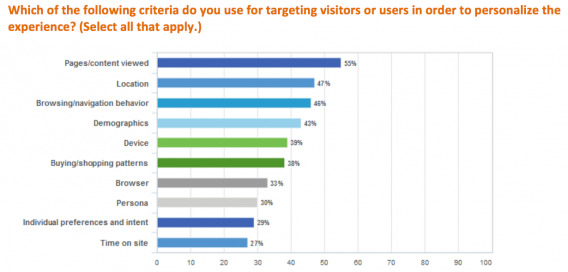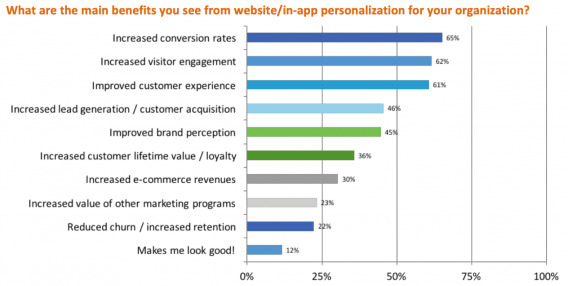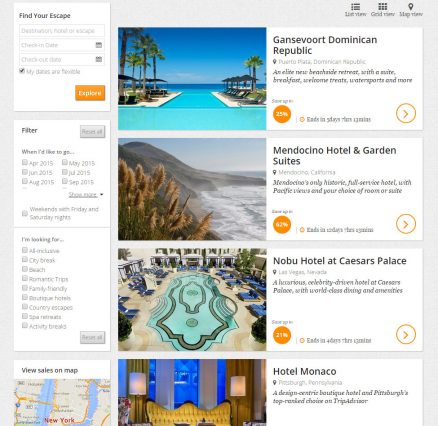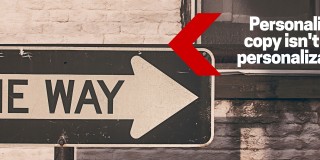In his famous novel, 1984, George Orwell wrote, “Big Brother is Watching You.”
When you’re browsing around online, someone is watching you, too. Actually, a lot of someones. Sites collect plenty of data about each and every visitor that passes through. “The more data, the better,” they say.
But you’re already well aware of that because all smart optimizers are watching their visitors (and customers) as closely as possible.
All of that data is now being used for website personalization in an effort to increase conversions. But, by their own admission and according to consumer opinion, it seems that companies are getting personalization all wrong.
The Current State of Personalization
In case you’re unfamiliar, personalization is the real-time individualization of a site to suit each visitor’s unique needs and guide them through a custom conversion funnel.
Here’s a personalized value proposition example from Optimizely…

And here’s a more simple personalized popup example…

Interest in personalization is growing quickly, according to Evergage’s 2016 Trends in Personalization. The study, which they conduct annually, found that 85% of those surveyed are implementing some form of personalization.
What shape do those implementations take? Well, quite a few, actually…
And what data are companies personalizing based on? That’s also varied. To start, it’s important to know what data is being collected. Here’s what CEB’s B2C Marcomm Personalization found…
Now, we can compare those data collection numbers to the data use numbers…
As you can see, there’s a big gap between what’s being collected and what’s being used. There’s an even bigger gap between what’s being collected and what’s being used in real-time personalization.
It’s also worth noting that Evergage found that those using personalization are largely taking advantage of rule-based targeting to segments (63%) vs. a more advanced 1:1 targeting strategy (22%).
All signs, so far, point to the fact that while the desire and data to personalize are there, companies are struggling to really understand and take advantage of it.
Results from Evergage’s study, which surveyed both B2C and B2B companies, were similar…
While efforts are undeniably being made to tackle personalization, few companies are satisfied with their results so far. In fact, 44% fall below the “moderately satisfied” point…
What’s interesting is that companies are actually the least satisfied with their website and mobile website personalization…
Despite the fact that website personalization is perhaps the most talked about form of personalization, companies are more satisfied with their level of personalization for mobile apps and web apps. That makes sense given you are bound to have more information on actual users vs. visitors passing through.
However, mobile and web app personalization is not where the majority of people are investing their resources…
Where companies are investing their personalization resources is almost the exact reverse of where they’re gaining the most satisfaction from personalization.
Bond Brand Loyalty conducted a survey and found that only 22% feel very satisfied with the level of personalization they experience with a loyalty program. (Down from 28% in 2015.)
That’s interesting because presumably, a loyalty program would be a prime place for personalization, much like apps.
But, as companies are the first to admit, they’re still in the early stages of figuring out how to do personalization right (despite the fact that the concept has been around for years)…
Why Companies Are Turning to Personalization
Ok, so they don’t have it perfected just yet, but what is making companies turn to personalization so rapidly in the first place? Most of them are chasing increased conversion rates and revenue…
And many of them are actually seeing some success…
Though, that success is certainly moderate for the amount of research and deployment work required. Actually, 74% of companies describe their personalization returns as “marginal”…
Still, companies are continuing to chase after these reported benefits…
…however elusive they may seem to many.
The Bond Brand Loyalty survey found a correlation between satisfaction with the loyalty program’s personalization and satisfaction with the loyalty program overall…
The benefits of personalization done well are endless and I would never argue against that. However, what companies expect to get from personalization and what they’re actually getting from personalization are seemingly two different stories.
What gives?
Case Study: Secret Escapes via Optimizely
Here’s an example of a company that has experienced success from personalizing the UX for logged in users. Secret Escapes used Optimizely to personalize their homepage for logged in users, which previously showed a long, random list of vacation listings…
Secret Escapes decided to test a more personalized approach, which rearranged the homepage vacation listings based on previous search behavior. For example, this is a variation that would be served to someone who had previously searched for “NYC” and “all inclusive”…
So, how exactly did it work? They personalized based on three factors…
- Last three search terms that landed the visitor on Secret Escapes.
- Most visited type of sale. For example, all inclusive.
- PPC keyword that originally brought the visitor to Secret Escapes.
For the New York keyword, Secret Escapes saw…
- A 24.4% increase in clicks to sale from the listing page.
- A 30.4% increase in clicks to the purchase page.
- A 210% increase in completed purchases.
These types of results are, of course, what draw companies to personalization. It’s what they’re searching for, but struggling to find.
The Internet’s Growing Privacy Concern
While talk of personalization has been increasing, so has concern over privacy, both online and offline. According to Pew Research Center…
- 86% of Internet users have taken steps online to remove or mask their digital footprints.
- 68% of Internet users believe current laws are not good enough to protect privacy online.
- In 2009, only 33% of Internet users were concerned about the amount of information about them that is available online. Today, that number is 50%.
Here are just some of the steps people are taking to be less visible online and protect their privacy…
Another report from Pew Research Center yielded similar results…
- 93% of adults say that being in control of who can get information about them is important.
- 90% say that controlling what information is collected about them is important.
- 50% of adults think that online advertisers who place ads on the websites they visit should not save records or archives of their activity for any length of time.
- 40% don’t even think that their search engine provider shouldn’t retain information about their activity.
This growing mistrust, especially in advertisers and online companies, is a big problem for personalization for two reasons…
- Most people don’t want you to have information on who they are and what they do online; they don’t trust you.
- Most people are actively trying to hide their information from you.
Scott Robinson from Bond Brand Loyalty explains it well…

Scott Robinson, Bond Brand Loyalty:
“Ironically, the very customer information that marketers seek to capture in order to evolve their efforts away from a one-size-fits-all approach and toward a tailored and delightful experience for customers is the very information that customers are increasingly concerned, even reluctant, about providing.” (via Bond Brand Loyalty)
So, Is Personalization Kinda Creepy?
HubSpot published an interesting article, Is Personalization Creepy? 6 Experts Weigh In, on whether personalization backfires and ends up creeping people out. Seth Fendley of ClearPivot began his opinion on the matter with these two sentences…

Seth Fendley, ClearPivot:
“Personalization is only creepy if you make it creepy. Only use personalization in areas where people expect it (after opting in, in emails, etc.).” (via HubSpot)
I both agree and disagree. I agree that personalization is only creepy if you make it creepy. If it’s not done well or if it’s overdone, it can absolutely come off Big Brother-ish and creepy…

However, I disagree with the notion that you should only use personalization where it’s expected. Instead, you should use personalization in a subtle way throughout the entire user experience.
Here are two guidelines that will serve you well…
- If it feels like you’re talking directly to a unique person and that unique person alone, it’s too much. (Excluding, of course, using provided names.)
- If they’re surprised that you know that information about them, it’s too much.
Generally, you don’t actually want people to be aware that you’re personalizing the experience.
Why? Because while marketers think personalization is a positive thing that makes consumers feel warm and fuzzy inside, consumers disagree in a big way…
CEB went on to say…
Much to most marketers’ chagrin, their customers are not big fans of it. Just under 400 consumers were asked an open-ended question about how “online ads that use details about what I have done” make them feel. Almost three-quarters (73%) were negative, and almost half used synonyms for “creepy” — including words like “hunted,” “naked,” “unsafe,” and “worried”.
Many consumers, it seems, feel compromised by personalized messaging and few find them valuable. Fewer than one-in-five said they find online messages “about products you have previously viewed online” (17%) and two-thirds (66%) have received “a lot of messages from brands that try to be relevant to me, but aren’t.”
How to Do Personalization in a Non-Creepy Way
Does all of this mean we should cut our losses and give up on personalization altogether? No way. What it means is that companies have to get smarter about the way they approach personalization.
1. Know Your Audience’s Personalization Tolerance
Personalization tolerance is simply how personalized the experience can seem without evoking negative emotions.
Of course, short of asking your audience how they feel about personalization and running tests, you can’t know for sure. Heuristically, however, you can draw some reasonable conclusions. For example, people who work in tech / marketing likely have a higher personalization tolerance than people who do not.
Be careful with this, though.
One might assume that the younger generation has a higher personalization tolerance. That, studies show, is false. Pew Research Center found that age has no impact on support for Internet anonymity. Another found that those who are younger are actually more likely to take steps to hide their information and behavior online.
The best way to judge personalization tolerance is to conduct conversion research, make a hypothesis and test it. Trust the data you get back, not what consumers say they want in surveys. Perhaps you can get away with more than you think. And perhaps not. After all, credibility and trust do impact conversions.
Either way, find out for yourself.
2. Add Value, Don’t Personalize Just Because You Think You Should
Don’t be a bandwagon optimizer. Just because people are talking about personalization, doesn’t mean you should be doing it. If personalization doesn’t add value for your visitors, don’t do it.
Andy Zimmerman of Evergage explains…

Andy Zimmerman, Evergage:
“Done well, personalization should add value for your visitors, helping them find what they are looking for or guide them in their journeys. Sufficient forethought needs to be applied to ensure it’s helpful. Personalization ‘just because you can,’ on the other hand, is never a good idea.”
It could be recommending a product the visitor might like or showing them a call to action based on the weather in their location or removing fields on a form if you already have that information… whatever. Just make sure it adds value, it brings the visitor closer to getting what he wants.
3. Don’t Show Your Hand
The question people concerned with online privacy (so, most people) have is this: How much information does this company actually know about me?
Think about it. People are reluctant to give out their email address. They don’t want to know you know what neighborhood they live in, what company they work for, what they are window shopping for, etc.
You do, of course. You know a lot about each person that visits your site. (Remember the “data collected” chart from above?) You collected the information legally and you’re not using it for evil, but consumers still don’t want to know too much about what you know.
Andy agrees…

Andy Zimmerman, Evergage:
“The best personalization creates experiences that customers view as personalized, but not too personal or intrusive.”
Personalize without showing your hand to avoid coming off as intrusive and untrustworthy. Just as “We never spam.” on a form can backfire (and make people consider the fact that you might spam them for the first time), so can “Looking for this, Shanelle?”
4. Perfect Targeting and Segmentation
As Andy explains, targeting and segmentation go hand-in-hand with not showing your hand…

Andy Zimmerman, Evergage:
“It’s important to listen to each visitor and respond individually. For example, factoring in website behaviors and past purchases into recommendations and email campaigns adds value to your customers, helps them avoid sifting through irrelevant information, and shows that you understand their intent – rather than that you just know a lot about them.”
The best way to explain the importance of targeting and segmentation is through a bad example.
Now, I did a lot of research into online privacy, consumer surveys and personalization tools while writing this article. My favorite comment on personalization comes from a thread on Inbound.org.
Alex Bayley of Eat Local Ballarat explains how Facebook misses the mark on newsfeed personalization thanks to poor targeting and segmentation…

Alex Bayley, Eat Local Ballarat:
“I recently started using Facebook again after a long hiatus. I spent a bunch of time following organic farms, farmers’ markets, and food activists (which of course I never see because the Facebook algorithm deems acquaintances’ baby photos more important).
I have a long browsing history of being into homegrown / homemade-from-scratch / whole foods (often vegetarian/flexitarian) and don’t have much of a sweet tooth, but I never follow, like, or in any way interact with anything weight-loss or diet-related (except to hide/unfollow).
I’m in Australia (southern hemisphere) where it’s winter. I’m single with no kids.
Then Facebook released the topical newsfeeds. ‘At last!’ I thought, ‘I will see all the food related posts from my organic farmer and food activist friends in one place. Maybe some cool vegetarian recipes or seasonal veggie tips.’
What do I actually see?
- Paleo clickbait
- gooey butter cookies
- Paleo clickbait
- a recipe for sandwiches (like actually “take bread and put stuff between it” as a recipe)
- kids food
- kids food
- clickbaity recipe for heavily processed food, “spaghetti bake”
- clickbaity recipe for “summer dessert” (it’s winter)
- Time Magazine article about avocados (vaguely interesting)
- diet tell-all from some athlete
- a list of top 50 gourmet restaurants I would never eat at
- “clean eating” clickbait
- article about summer outdoor eating (it’s winter)
- something about tinned fish being bad for the environment (vaguely interesting)
- a post from a local farmers’ market that I’ve already seen six times for some reason
- a tech publication writing about a naked restaurant (insulting clickbait)
- unscientific claims about cancer-beating superfoods
- kids food
- gooey desserts
- kids food
- vegan curry recipe that I’ve seen before
- Middle-Eastern pastry recipe that I’ve seen before
- clickbaity article about blended chickpea juice as vegan egg substitute (that I’ve seen before)
- homemade Halloween candy recipe (wrong season, wrong continent, not something I would ever eat)
- “you have to buy me pizza” Facebook chain letter
If this is the best “personalisation” that one of the biggest, creepiest companies on the planet can manage, I’m just shaking my head.
This isn’t like someone who’s Facebook stalked me. It’s like someone who comes up to me at the farmers’ market and starts shouting random words like, “GOOEY KIDS DIET DIET PACKET OF CREAM CHEESE PALEO KIDS SUMMER EAT FOOOOOD”.
And when I’m like, “Whuuuuh?” they’re like, “Well you’re shopping at the farmers’ market, I assumed you liked this stuff.” Then they follow me home and stand outside my door still shouting it.
Don’t be like Facebook. Try to actually understand beyond the broadest segments, or don’t bother.” (via Inbound.org)
And that is why 1:1 personalization, which the reports we went through earlier show companies are rarely doing, is so effective.
Personalization is about going deeper than “like food stuff” without going as far as “You were on our mobile app last night at 9:02 p.m. while you were eating at Pub ABC and searching for goat cheese recipes, so here are some goat cheese recipes from people in your neighborhood.”
That balance requires a lot of research and testing to achieve.
Conclusion
You can use personalization without coming off as Big Brother and creeping everyone out. But it’s a lot harder than most companies expect. [Tweet It!]
Personalization is continuing to gain popularity, but resulting improvements are marginal for a lot of companies. As an industry, we haven’t really “figured it out” yet. At the same time, concern over online privacy is skyrocketing, creating even more problems for personalization.
Here’s what you should keep in mind to really get the most out of personalization…
- If it goes too far, personalization is undeniably creepy. It should be subtle enough that most people aren’t aware you’re personalizing the experience.
- Do the research and testing required to understand your audience’s personalization tolerance. You don’t want to hurt credibility or diminish trust.
- Use personalization to add value instead of personalizing just because you think it’s something you should be doing now.
- Don’t show your hand… be careful what you imply you know about your visitors and customers.
- Perfect targeting and segmentation so that 1:1 personalization becomes a viable option for your company.





















Great article, Shanelle!
Thanks so much, Andrea!